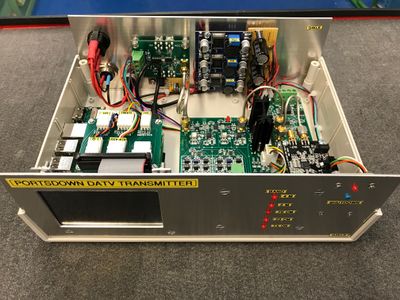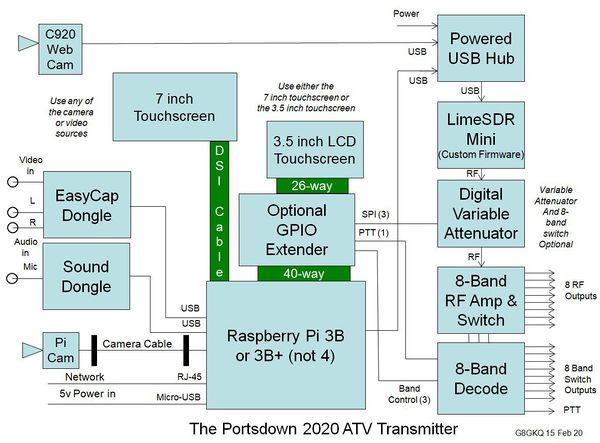The Portsdown DATV transceiver system
Introduction
The aim of the Portsdown project is to enable an amateur radio operator with little or no knowledge of Digital ATV to construct the hardware elements, load and configure the software and use the system to send live Digital ATV signals across town on his existing aerials.
The Portsdown DATV transmitter project provides an easy way to “get on air” with Digital ATV at a relatively low cost covering all of the commonly used DATV modes enabling it to be used for cross town QSOs, accessing ATV repeaters and for working the DX using Reduced bandwidth (RB-TV) modes.
The project, which was featured in the June 2017 issue of the RSGB's Radcom magazine, involves some basic construction and is based around a Raspberry Pi with a touchscreen and uses a LimeSDR Mini - before January 2019 the Portsdown used a custom filter modulator card and external local oscillator.
Outline specification of the Portsdown system is as follows:
• Frequency coverage of the 50, 71, 146 MHz, 437 MHz, 23cms, 13cms and 3.4GHz ATV bands when using LimeSDR mini
• MPEG-2 and MPEG-4 (H264) video encoding
• Cost-effective stand-alone (not PC based) Digital TV Transmit solution
• Wide range of Symbol rates from 125 Ks to 4Ms* including Reduced Bandwidth (RB-TV) modes and “normal” DATV modes
• Analogue video input to allow use of camcorders and mixing desks
• Use of commonly available components and modules
• Modular construction enabling a step-by-step system build and easy trouble shooting
• Designed to encourage home construction and requiring an average skill level
• Fully documented and supported including easy software installation and upgrades
• Can be received on a standard Free to air satellite receiver
System overview
At the heart of the The Portsdown Transmitter is a Raspberry Pi (RPi) computer running a BATC customised version of the F5OEO rpidatv software. The choice of the RPi is primarily due to the fact that it has an on-board MPEG-4 (H264) encoder and the versatile hardware interface (GPIO) capabilities.
From January 2019 the custom BATC Filter Modulator board has been replaced by a LimeSDR Mini. This covers a wider frequency range and adds DVB-S2 capability.
Touch screen control
A touch screen interface enables the system to be used as a standalone unit without further need to connect up keyboard and mouse. If the LCD is not available, the system can be controlled by using an external PC connected over a wired or wi-fi network (console mode).
RF Generator and DATV Modulator
The output from the RPi is connected to a LimeSDR Mini (or the original Filter Modulator board) which modulates the RF carrier and produces the DVB-S or DVB-S2 DATV signal.
Audio and video inputs
The Portsdown transmitter will take audio and video inputs from the RPi camera, an EasyCap composite video USB dongle, C920 webcam and a USB sound card / dongle - all these are readily available from ebay and Amazon.
Portsdown Evolution
There are now 4 distinct Portsdown versions:
Portsdown 2018 Classic
The was the original version launched in 2017 - Portsdown 2018. It was based on the Raspbian Jessie operating system running on a Raspberry Pi 3 with a 3.5 inch touchscreen. It used the BATC-supplied Filter-Modulator board and could take video from the Raspberry Pi Camera or the EasyCap. It would transmit DVB-S MPEG-2 with audio, or H264 without audio.
This version is no longer supported, although it will continue to work as built.
Portsdown 2019 Stretch
This was the second version, using the Raspbian Stretch Operating System - Portsdown 2019. Support for the 7 inch touchscreen was added and some WebCams could also be used as a video source. Audio capability was added for H264 encoding, and early support was provided for the LimeSDR Mini.
Later versions also supported the LongMynd receive software enabling good DATV reception using a MiniTiouner.
Again, this version is no longer supported, although it will continue to work as built.
Portsdown 2020 Buster
The current in-use version of the Portsdown is Buster 2020 - Portsdown 2020. This introduces support for the LimeDVB firmware on the LimeSDR Mini and also supports the use of standard firmware on the LimeSDR USB and the LimeNET Micro.
The LongMynd receive capability has been improved with the addition of a player that will display some H265 signals. It will also control an external Jetson Nano with an HDMI capture device to allow the transmission of high definition H265 signals.
This version will continue to be actively supported while the Buster operating system is current for the Raspberry Pi. No date has yet been set for release of the next operating system version (Bullseye).
Portsdown 4
The next version of the Portsdown will be the Portsdown 4 - Portsdown 4. This will use the Raspios Buster (NOT Raspbian) operating system on a Raspberry Pi 4 with a 7 inch screen and a LimeSDR. Unlike the previous version changes it will not maintain hardware compatibility with the classic (filter-modulator) Portsdown.
You may have seen mention of the Portsdown A27 – this version was the stepping stone from the Portsdown Buster 2020 to the Portsdown 4, and will not be continued after the release of Portsdown 4. First development release of the Portsdown 4 should be during July or August 2020.


